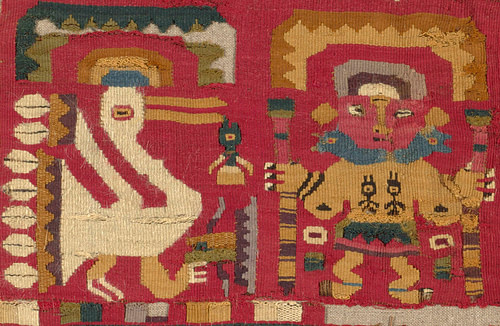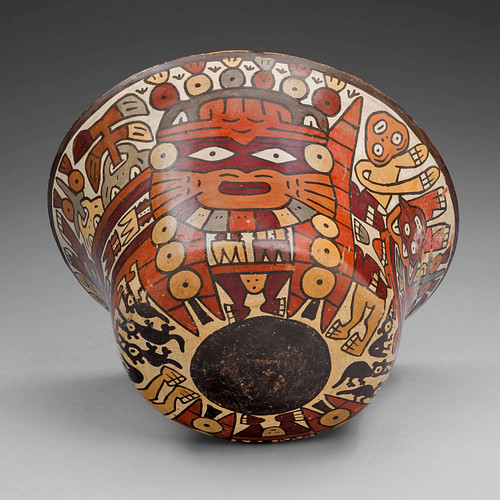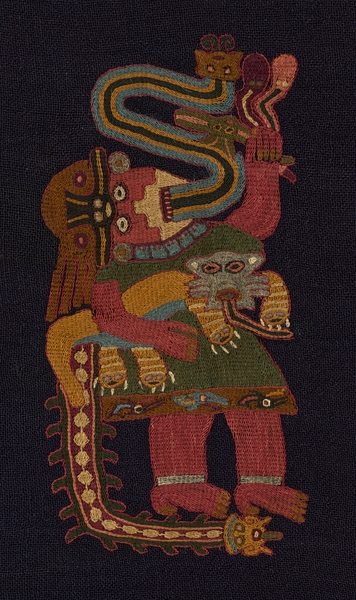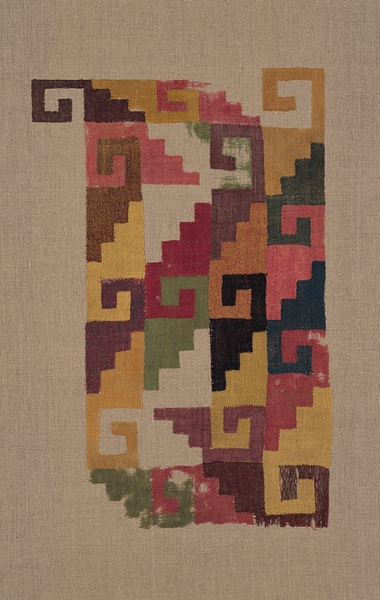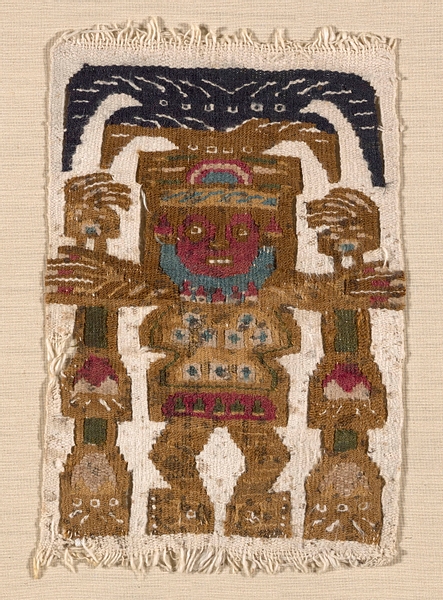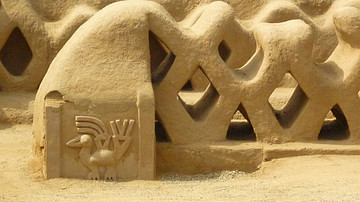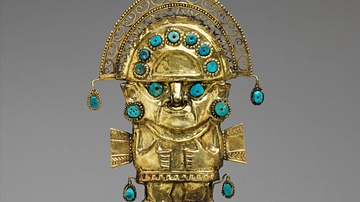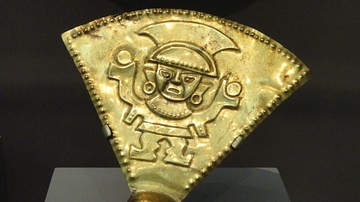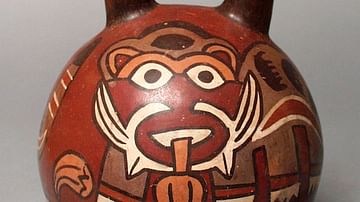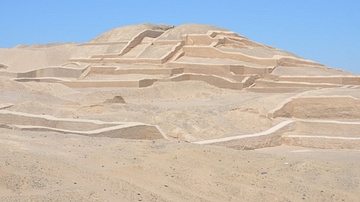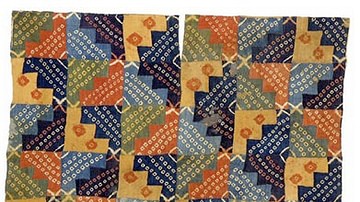Over the course of several millennia, textiles were the primary form of aesthetic expression and communication for the diverse cultures that developed throughout the desert coasts and mountain highlands of the Andean region. Worn as garments, suspended on walls of temples and homes, and used in ritual settings, ancient Andean textiles functioned in multiple contexts, yet, within each culture, the techniques, motifs, and messages remained consistent. A new exhibition - Super/Natural: Textiles of the Andes - at The Art Institute of Chicago, showcases the beauty and importance of these ancient textiles. In this exclusive interview with co-curators Elizabeth Pope (Arts of Africa and the Americas) and Erica Warren (Textiles) from The Art Institute of Chicago, James Blake Wiener of Ancient History Encyclopedia (AHE) learns more about the prominent position of textiles within pre-Columbian Andean cultures.
JBW: Elizabeth and Erica, thanks so much for speaking with me about Super/Natural: Textiles of the Andes, which is on view at The Art Institute of Chicago until June 16, 2019. I wanted to begin by asking you why The Art Institute of Chicago sought to present an exhibition on Andean textiles?
EP & EW: At the Art Institute as part of the permanent collection installation in the Arts of the Americas gallery, we feature a rotation of Andean textiles. We collaborate cross-departmentally on this rotation, which includes selecting the objects, researching and writing labels, designing the display, and installing the works of art. The Art Institute's Andean textile collection has great breadth in terms of geography as well as chronology, and we wanted the opportunity to tell a bigger and more focused story about these objects. The main point that the exhibition makes is that textiles were/are the primary mode of aesthetic and cultural expression across the Andes region. The quantity and quality of textiles produced throughout the Andes speaks to this assertion, as do the complex and numerous techniques the Andeans employed in producing these objects.
This exhibition gives our audiences the opportunity to see the depth and variety of textile-making practices over the course of two millennia; moreover, about a third of the seventy-two objects in this special exhibition have never been on view before!
JBW: The Department of Textiles at The Art Institute of Chicago contains more than 13,000 textiles and 66,000 sample swatches ranging from 300 BCE to the present. The museum, itself, has a collection of more than 260,000 artworks. These are quite impressive figures! One should note too that the Andean region encompasses an area that traverses present-day Venezuela, Colombia, Ecuador, Peru, Bolivia, Chile, and Argentina.
I am curious to know how curators choose the 60 textiles and a small selection of ceramics that are featured within the exhibition. Was this a daunting task or was it one that was relatively straightforward?
EP & EW: Although the collection is substantial, the textiles guided the choices that we made. The strengths of the collection, which include textiles from pre-Columbian coastal communities as well as the modern highlands, led us to highlight a range of creative approaches to design as well as technique. The ceramics and other related works included in the exhibition were chosen after the textile checklist had been narrowed. These complementary objects beautifully reinforce the central theme of textile primacy.
JBW: A few pieces within Super/Natural: Textiles of the Andes come from the Paracas culture (c. 500 BCE to 200 CE), which flourished in the coastal regions of southern Peru. Could you tell us a bit more about this intriguing culture and its textiles? What is it that stands out about them in your estimation?
EP & EW: Research and archaeology on the Paracas indicates that textiles were ubiquitous in the culture, and the embroidered textiles in particular stand out for their color and detail. A prime example featured in the exhibition is the expansive mantle (1970.293), which has over 50 embroidered anthropomorphic figures with their heads tilted backwards, one arm upraised, and the other holding a feline. Although the embroidery is done in a single type of stitch, and on a plain weave ground, the spinning, weaving, and indigo dyeing of the ground fabric as well as the dyeing of the embroidery threads, in a wide palette of colors, suggest a high degree of sophistication and specialization.
We are uncertain whether or not these labors were divided amongst individuals so that dyeing, weaving, and embroidery were separate areas of professional expertise. Nevertheless, Paracas embroidery provides just a small window onto the complex processes and time-consuming labor required to make these astonishing works.
JBW: Major Andean civilizations are well featured within the exhibition with pieces from the Nazca (c.100 BCE - 800 CE), Lambayeque (c. 750 - c. 1375 CE), and Chimú (c. 900-1470 CE) cultures (there are no Chimú objects in the exhibition). Does the exhibition include pieces from lesser known cultures and civilizations as well? If so, which ones?
EP & EW: In terms of the pre-Columbian part of the exhibition, there are objects from the Rimac as well as the Chancay culture. We certainly have the least information about the Rimac, but believe the exhibition, which situates the Rimac amongst related coastal communities of the Lambayeque and Chancay, offers audiences a framework for understanding these textiles. These three cultures, roughly contemporaneous, produced textiles that have similar representational approaches in terms of the anthropomorphic and animal figures. While we may not be able to offer many details about the larger Rimac culture, the potential for future discoveries remains exciting! Archaeological research is ongoing and may someday offer further insights and understanding!
JBW: Works from the museum's collection reflect similar designs and patterns for textiles and ceramics that developed in different areas of the Andes.
What are the common elements from each of the cultures represented within Super/Natural: Textiles of the Andes across time and space? Moreover, how does one explain these striking similarities?
EP & EW: In choosing objects for the exhibition, we absolutely wanted to be sure to convey the cross-cultural connections that the textiles elucidate. The key shared themes that the exhibition highlights are the supernatural, the natural, the everyday, and the afterlife. In addition to these shared themes, the way in which they are expressed in the designs of objects often comes across as strikingly similar, as you note. The stepped fret motif appears on a number of objects throughout the exhibition including the Nazca panel fragment (1956.76), which possibly functioned as a wall hanging, two of the Nazca ceramics, as well as two of Lambayeque textiles.
While the exact details surrounding the exchange of design knowledge remains a bit opaque, it is clear that none of these communities were isolated or insular. There was an awareness of a larger world, which came about in part due to the trade in goods and materials, including cotton and wool. Coastal communities grew cotton, while highland communities husbanded llamas and alpacas for their lush wooly fleece. The textiles provide evidence of trade as many of them incorporate both materials in a single work.
JBW: Would you say that the exhibition additionally highlights the unique aspects of Andean artistic diversity? Do these textiles afford an evocative glimpse into the cultures that made up one of the “cradles of civilization”?
EP & EW: In designing the exhibition, we arranged the objects in such a way as to create distinct cultural conversations, in the hope that visitors will get to know each culture and their textiles within a defined space of the galleries. As you move through the exhibition, you move through space and time and meet distinct cultures and learn a little about the specificity of their textile production.
We absolutely think that these textiles provide "an evocative glimpse" and an unparalleled opportunity to see objects made hundreds, sometimes even thousands, of years ago. Textiles were the earliest and most prevalent form of artistic expression throughout the region, and the techniques, as well as the designs, provide a fascinating glimpse into the lives of people who lived hundreds of years ago. The objects ask us to consider how people lived and how they understood their existence and the world around them. Moreover, these textiles and ceramics have lived more lives than any of the people who made or used them, and they have an ongoing existence within The Art Institute's collection, which make them compelling and thought-provoking.
JBW: Which environmental conditions enabled the survival of the ancient Andean textiles and embroideries over successive millennia? I assume the dry desert climate and elevated terrain helped preserve many textiles, but I would also surmise that much was still lost following the Spanish conquests in the 16th century CE.
EP & EW: You assume correctly! The extremely dry conditions along the desert coast fostered the preservation of textiles. The highlands do not have as consistent of a climate, and therefore fewer textiles remain from the pre-Columbian years. Fortunately, we are collecting modern and contemporary textiles from the highlands as a complement to these early works and to highlight the fact that weaving continued despite the Spanish colonial forces that radically changed the lives of many Andean communities.
JBW: As curators, what do you hope museum visitors learn from a visit to Super/Natural: Textiles of the Andes? Tangentially, have you a favorite piece within the exhibition? If so, what is it and why should visitors not miss it?
EP & EW: We hope that visitors will come to appreciate that textiles are complex and diverse in ways that people nowadays often take for granted! This is a remarkable opportunity to see works of art and rethink notions about ancient cultures and technology.
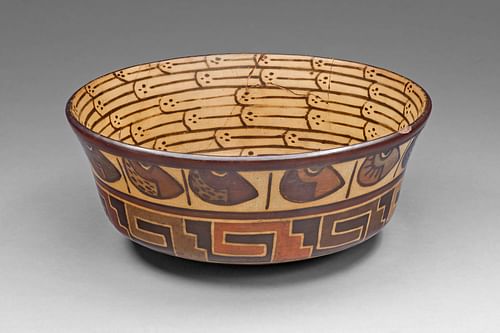
While it is difficult to pick a favorite work, we each can discuss an object that shouldn't be missed!
EP: I find particularly compelling the Nazca border fragments, which originally would have been attached to a larger fabric panel, like a fringe. They display the exceptional skill of the weavers, who created these three-dimensional figures using looped and cross-looped needlework. Moreover, on a scale no more than two inches in height, a full range of motifs and symbols are presented: costumed warriors and ritual performers that reference supernatural and otherworldly beings as well as birds, insects, and plants from the natural landscape.
EW: I really want visitors to look closely at the Rimac tapestry woven fish included in the exhibition. One of the details that makes this object remarkable is the fact that it was woven to shape, which means that all of the edges (over twelve!) that form the outline of the fish's body are finished. The precise planning required to design and make this object is truly astonishing!
JBW: Elizabeth and Erica, I thank you so much for your time and consideration. I appreciate the knowledge that you have shared with us, and I thank you and The Art Institute Chicago for your time and consideration.
EP & EW: Thank you for taking time to chat with us further about the exhibition, James. We hope that we have inspired or fostered further a fascination with these artworks, and perhaps some Ancient History Encyclopedia fans will visit us at The Art Institute in Chicago!
Super/Natural: Textiles of the Andes is on view at The Art Institute of Chicago in Chicago, IL until June 16, 2019.
Elizabeth Pope is the Collection Manager and Research Assistant in the Department of the Arts of Africa and the Americas, where she has worked since 2005. Previous curatorial appointments include the Edward and Betty Marcus Curatorial Internship at the Dallas Museum of Art, Department of New World Cultures; and Curatorial Intern at Yale University Art Gallery, Department of Ancient Art. She also has co-organized and contributed to several additional exhibitions and art installations, including those at the Textiles Society of America, University of Texas at Austin's Benson Latin American Collection, and the Adler Planetarium. Her publications include contributions to the Indian Art of the Ancient Americas at the Art Institute of Chicago with Richard Townsend, as well as several additional Art Institute publications. She recently was selected by the Archaeological Institute of America to be the 2019/2020 Webster Lecturer in Archaeoastronomy. Elizabeth is a specialist in pre-Columbian Mesoamerican art, architecture, and ritual performance with a particular focus on the cosmology and cosmogony of the ancient Maya. She received a Ph.D. under the direction of Dr. Linda Schele at UT, Austin, Department of Art and Art History. She also earned an MA in Archaeological Studies from Yale University; and studied non-western cultural cosmologies as an undergraduate at Colgate University, working directly with Dr. Anthony Aveni, receiving a BA in Comparative Cultures.
Erica Warren is assistant curator in the Department of Textiles at the Art Institute of Chicago. Prior to her appointment at the Art Institute, she was a curatorial fellow in the Department of European Decorative Arts and Sculpture and a research assistant in the Department of American Art at the Philadelphia Museum of Art. She has taught courses on the history of design and craft at Drexel University and at the Tyler School of Art, Temple University. She earned her Ph.D. in art history from the University of Minnesota and MA from New York University. She also has participated in the Attingham Summer School. Erica specializes in 19th- and 20th-century CE decorative arts and textiles, particularly European and American, and has interests in contemporary fiber art, textiles, and design as well. She recently curated Super/Natural: Textiles of the Andes, and her previous exhibitions include Music and Movement: Rhythm in Textile Design (May 18, 2018 – January 6, 2019), Making Memories: Quilts as Souvenirs (October 20, 2017-April 1, 2018) and Modern Velvet: A Sense of Luxury in the Age of Industry (October 21, 2016-March 19, 2017). While in Philadelphia, she curated the exhibition The Main Dish (2014). Her forthcoming (2019) essay “Making the Timeless: Anni Albers, Mesoamerican Sculpture, and the 'Thing Itself'” examines Anni Albers's understanding of pre-Columbian Mexican art and its impact on her weavings. Erica also contributed a number of entries on modern decorative arts and design to the Bloomsbury Encyclopedia of Design and has written and lectured on Scandinavian design, with a particular focus on Norway and late 19th- and early 20th-century CE art and nationhood.
